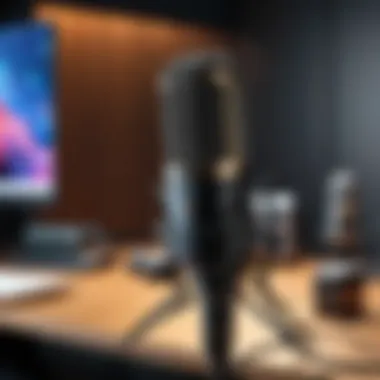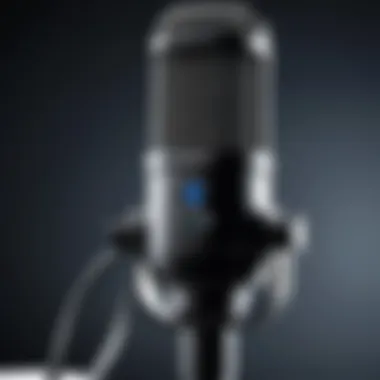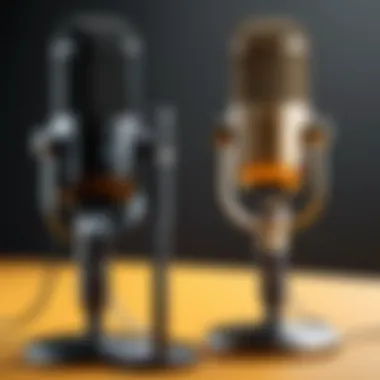Discover the Best Value Podcast Microphones


Intro
As the podcasting landscape continues to evolve, having the right microphone is crucial for both aspiring and seasoned creators. Finding a microphone that offers great value without compromising on sound quality can be daunting. This guide aims to equip you with the necessary insights to navigate this intricate decision-making process.
Understanding the differences between various models and their sound profiles can make a significant impact on your podcast's production value. Budget plays a critical role as well, as some options can be prohibitively expensive yet do not provide a substantially better experience than more affordable choices. The right microphone not only enhances your audio quality but also your credibility as a podcaster.
Throughout this guide, we will explore the essential aspects of selecting the best value podcast microphone. Key topics include hardware specifications, performance metrics, and features that make certain models stand out in a crowded market. By synthesizing this information, you will be able to make a well-informed choice that aligns with your specific needs.
Hardware Overview
When delving into microphones, it is imperative to understand the hardware components that define their functionality. Key specifications can differ widely across models.
Specifications
The essential specifications to consider include:
- Type of Microphone: Dynamic versus condenser, each offering different advantages. Dynamic microphones often handle high sound pressure levels and are more durable. On the other hand, condenser mics capture a broader frequency range and detail, making them suitable for studio environments.
- Polar Pattern: Understanding whether a microphone is omnidirectional, cardioid, bidirectional, or supercardioid helps ensure the desired sound capture and minimizes unwanted ambient noise.
- Frequency Response: This measures a microphone's sensitivity across different frequencies, indicating how well it picks up sound.
Performance Metrics
Evaluating performance metrics gives insight into a microphone's reliability and suitability. Some important metrics include:
- Signal-to-Noise Ratio: A higher ratio indicates cleaner audio. Aim for devices with a ratio above 70 dB.
- Max SPL: The maximum sound level a microphone can handle without distortion. This is vital when recording loud sound sources.
- Self-Noise: Lower self-noise is critical for quiet environments to avoid distracting background sounds.
"The right combination of specifications can significantly elevate the quality of your recordings, making the difference between a good and great podcast."
In summary, understanding hardware specifications and performance metrics will guide you in selecting a microphone that provides the best value. This knowledge allows for informed decisions based on the specific needs of your podcasting setup, ultimately optimizing your production value and listener experience.
Foreword to Podcast Microphones
In the realm of podcasting, the significance of selecting the right microphone cannot be overstated. This article aims to explore various aspects of podcast microphones, primarily focusing on the concept of value. Understanding what constitutes quality audio and recognizing the best options available at reasonable prices are crucial for anyone embarking on a podcasting journey. The market offers a wide range of products, making the art of selection both challenging and essential.
The Importance of Quality Audio
Quality audio serves as the cornerstone of effective podcasting. Unlike video, where visuals can capture attention, audio is what engages listeners long term. Poor sound quality can detract from the content and diminish the overall listening experience. Research indicates that audiences tend to abandon shows due to substandard audio, emphasizing the need for a microphone that delivers clear and crisp sound.
When investing in a microphone, it is essential to consider factors like sensitivity, frequency response, and signal-to-noise ratio. These elements collectively influence the clarity and quality of the recorded sound. A microphone that accurately captures vocal nuances can elevate a podcast, making it more enjoyable and professional.
Defining the Best Value
Best value in podcast microphones is not merely a matter of price. It involves a balance between cost and performance. For many creators, finding a tool that offers excellent audio quality without breaking the bank is paramount. Therefore, when defining the best value, one must look at various elements, such as durability, features, and feedback from users.
Ultimately, the best value microphone should provide serviceable performance, robust build quality, and accessibility for beginners and seasoned podcasters alike. It should be the type of equipment that fosters growth in production skills, rather than a limitation. As we delve deeper into this guide, these principles will guide our exploration, providing a clear framework for evaluating what resonates as true value in the podcasting sphere.
Understanding Microphone Types
Understanding the various types of microphones is fundamental for anyone serious about podcasting. Each type serves different purposes and provides distinct sound characteristics. Knowing these attributes helps podcasters make an informed decision when selecting equipment that fits their specific needs. In this section, we delve into three primary microphone types: dynamic, condenser, and lavalier microphones. This knowledge can significantly influence the quality of a podcast and the overall listening experience.


Dynamic Microphones
Dynamic microphones are robust and versatile, making them an excellent choice for various recording environments. They operate on a simple principle of electromagnetic induction which allows them to handle high sound pressure levels without distortion. This makes them particularly effective for loud sound sources, such as live performances and recording vocals with significant energy.
One of the key benefits of dynamic microphones is their durability. Constructed to withstand rough handling and stress, they are suitable for both studio and field work. For podcasters, especially those who might record on the go, this feature adds peace of mind.
Some popular models include the Shure SM7B and the Audio-Technica ATR2100x-USB. Each model varies in price and specific features, but generally, they deliver reliable performance within a budget-friendly range.
Condenser Microphones
Condenser microphones are favored for their sensitivity and frequency response. They utilize a diaphragm that captures sound waves, delivering nuanced audio quality. This is particularly beneficial in controlled environments, such as studios, where clarity and detail are paramount.
Due to their sensitivity, condenser microphones are ideal for capturing vocals, acoustic instruments, and nuanced sound effects. However, they can pick up background noise easily, necessitating a quieter recording space. This makes them less suitable for less controlled environments, especially in podcasting scenarios where external noise can interfere.
Noteworthy models include the Rode NT1 and the Blue Yeti, both of which offer a range of features aimed at optimizing sound quality. They are often endorsed for their ability to capture crisp and clear audio effectively.
Lavalier Microphones
Lavalier microphones, commonly known as lapel mics, are small and can be clipped onto clothing, providing a hands-free option for recording. They offer great convenience for interviews, discussions, and on-the-go content creation. Their discreet design allows for unobtrusive operation, making them ideal for video podcasts.
One significant advantage of lavalier microphones is their ability to capture sound from the speaker while minimizing ambient noise. This is crucial for producing clear audio in settings where background sounds might detract from the conversation. However, users must be cautious regarding their placement to avoid clothing rustle, which can interfere with the recording.
Popular lavalier options include the Rode SmartLav+ and the Sennheiser ME 2-II. Each model varies in compatibility with devices and features but tends to fall within an accessible price range.
By understanding these types of microphones, podcasters can choose the appropriate equipment that aligns with their content style and recording conditions. Each type offers unique benefits and considerations that should be evaluated carefully to optimize podcast quality.
Key Features to Consider When Choosing a Microphone
Selecting a microphone for podcasting is not a trivial task. The features you consider can significantly affect your audio quality, which, in turn, influences your listeners' experience. Understanding these features is essential for making an informed choice. Below are key aspects that should be on your radar when evaluating potential microphones.
Polar Patterns
The polar pattern of a microphone defines how it captures sound from different directions. This characteristic is crucial for podcasters. Common polar patterns include
- Cardioid: Captures sound primarily from the front while rejecting noise from the sides and rear. This is ideal for solo podcasters or interviews where background noise may be a concern.
- Omnidirectional: Captures sound evenly from all directions. This may be useful for group discussions, but it can pick up unwanted ambient noise.
- Bidirectional: Captures sound from the front and back, making it suitable for interviews between two people facing each other.
Selecting the right polar pattern helps ensure clarity and focus in your recordings. It can enhance your overall production quality.
Frequency Response
Frequency response measures how well a microphone captures different sound frequencies. A wider frequency response range is often better because it can reproduce vocals more accurately. Standard speech frequencies generally range from 85Hz to 255Hz, but a microphone that captures a broader range enhances versatility, allowing for musical incorporation or special effects. Look for microphones that can reproduce frequencies from low bass tones to high treble sounds effectively. This will improve your ability to engage an audience with diverse audio content.
Connectivity Options
Connectivity options vary among microphones and can affect ease of use and flexibility. Here are some common types:
- USB: Great for beginners and direct attachment to computers, simplifying setup.
- XLR: Preferred by professionals for its high-quality sound and compatibility with audio interfaces and mixers.
- Wireless: Offers mobility but can be more expensive and may require careful setup.


Choosing the right connectivity can significantly impact your workflow. Consider your recording environment and make sure the microphone you select suits your intended setup.
Budget Constraints
Budget should always be a consideration in selecting a microphone. However, it is crucial to balance cost with quality. Expensive models tend not to guarantee better sound if they do not fit your specific needs. For podcasters on a tight budget, some brands offer surprisingly good quality without breaking the bank. Research and read reviews before making a purchase. Finding a microphone that aligns with your budget while providing adequate quality is key to a satisfactory product.
The microphone you choose can be an investment in the quality of your podcast, so a well-informed decision is advantageous.
For more details, it may help to consult consumer reviews or trusted resources like Wikipedia, Britannica, or various discussion threads on Reddit.
Evaluating Performance Metrics
Evaluating performance metrics is a crucial aspect when selecting a podcast microphone. This section emphasizes the importance of various technical specifications that affect audio quality. Understanding these metrics enables podcasters to make informed decisions that enhance their content production quality.
The focus on performance metrics like sensitivity levels, signal-to-noise ratio, and durability helps in distinguishing between microphones that simply look good on paper and those that deliver superior audio clarity in real-world applications. Recognizing these elements ensures that podcasters invest in equipment that aligns with their needs and expectations, improving listener experience significantly.
Sensitivity Levels
Sensitivity in microphones refers to the ability to pick up sound. It is typically measured in decibels (dB), with higher sensitivity values indicating a greater capacity to detect softer sounds. This is particularly vital in podcasting where vocal clarity is essential. A microphone with a sensitivity level of around -40 to -60 dB is generally suitable for most podcasters.
Benefits of high sensitivity include:
- Picking up subtle vocal nuances.
- Reducing the need for excessive gain that can introduce distortion.
However, it's also essential to avoid overly sensitive microphones in noisy environments, where background noise can become a problem. Thus, selecting a microphone with balanced sensitivity is key for achieving optimal audio recording.
Signal-to-Noise Ratio
The signal-to-noise ratio (SNR) measures the level of a desired sound compared to the level of background noise. A higher SNR indicates better performance because it signifies that the audio signal prominently stands out over unwanted noise. For podcasting, an SNR of 70 dB or more is generally recommended for producing clear and crisp audio.
A good SNR ensures that the listener's attention is drawn primarily to the host's voice rather than ambient sounds.
A high SNR is essential in any microphone designed for capturing spoken word, as it significantly affects the listener experience.
Durability and Build Quality
Durability and build quality play a substantial role in a microphone's performance over time. Podcasters often travel or move equipment, making robust construction a necessity. Microphones constructed from quality materials can withstand the rigors of regular use and transport without compromising audio fidelity.
Key considerations include:
- Material Quality: Metal-bodied microphones tend to offer better durability compared to plastic ones.
- Shock Mounts: Built-in shock mounts help reduce handling noise.
- Wind Screens: These can protect your mic from unwanted noise during recording sessions outdoors.
Investing in a well-built microphone is a long-term strategy. It contributes not only to sound quality but also to the overall reliability of your podcasting setup.
Top Budget-Friendly Podcast Microphones
When diving into the world of podcasting, the choice of microphone can significantly impact the overall quality of the final product. For many podcasters, especially those just starting out or operating on a tight budget, selecting budget-friendly microphones is essential. It is important to balance cost with sound quality and functionality. This section will closely examine various budget-friendly microphone models, allowing readers to make informed decisions about their audio equipment.


Model Comparisons
In evaluating budget-friendly podcast microphones, comparing various models provides clarity on which ones deliver the best value. Several brands have crafted microphones that cater to budget-conscious professionals while still maintaining acceptable audio quality.
- Audio-Technica ATR2100x-USB
This dynamic microphone is popular for its versatility. It offers both USB and XLR outputs, providing options for directly connecting to a computer or an audio interface. Its cardioid polar pattern effectively reduces background noise, enhancing audio clarity. - Blue Snowball iCE
A well-regarded condenser microphone, ideal for beginners. The Snowball iCE connects via USB and has a straightforward setup. Its sound quality is impressive for the price range, though it may capture some ambient noise due to its omnidirectional pattern. - Samson Q2U
Another great dynamic option, similar to the ATR2100x-USB. The Q2U is highly portable, with both USB and XLR outlets, making it suitable for podcasters on the move. This model is known for producing authentic sound with minimal distortion. - Fifine K669B
The K669B is an affordable USB condenser microphone that does not compromise too much on sound quality. It is compact and easy to use, making it a solid choice for podcasters who need a simple, effective solution without a hefty price tag.
These models exhibit a range of characteristics in sound quality, connectivity options, and ease of use. By comparing their strengths and weaknesses, it becomes easier for podcasters to determine which microphone aligns with their specific needs.
User Reviews and Feedback
User feedback provides invaluable insights into the performance and reliability of budget-friendly microphones. The experiences of podcasters can help others navigate their purchasing decisions.
- Audio-Technica ATR2100x-USB: Users frequently praise this microphone for its durability and sound quality. Many commend its versatility, stating that transitioning from USB to XLR is seamless. However, some have mentioned that it requires a pop filter due to its sensitivity.
- Blue Snowball iCE: Many users highlight the Snowball iCE as an excellent entry-level microphone. Its plug-and-play functionality is often noted, making it a favorite among beginners. On the downside, some reviewers caution against using it in noisy environments due to its omnidirectional capability, which picks up background sounds easily.
- Samson Q2U: Feedback reveals high satisfaction among users, particularly regarding sound consistency. Podcasters appreciate its dual connectivity options. A few users suggest that the stand could be sturdier, but overall, it remains a popular choice.
- Fifine K669B: The K669B is often applauded for its sound clarity at an affordable price. Users report a surprisingly rich audio profile, making it great for various recording scenarios. Some users mentioned a slight background noise, which they managed by adjusting the input levels.
User reviews encapsulate the practical aspects of each microphone's performance, informing potential buyers of what to expect. This information is crucial for podcast enthusiasts seeking to optimize their recording setups without straining their budgets.
Setting Up Your Podcasting Space
Setting up your podcasting space is critical to achieving high-quality audio for your recordings. The environment in which you podcast can significantly influence sound quality, and understanding how to optimize it is essential for both beginners and seasoned podcasters. This section explores key elements like acoustic treatment and microphone placement techniques. These factors can not only improve your audio clarity but also help in creating a professional atmosphere.
Acoustic Treatment
Acoustic treatment involves modifying your recording space to manage how sound travels and interacts with surfaces. The goal is to minimize reflections and reverberations that can lead to echo or muddled audio. Here are some important considerations for effective acoustic treatment:
- Identify Sound Reflections: Look for flat, hard surfaces like walls, floors, and windows that may bounce sound waves. Sound waves can create echoes if they do not have a surface to absorb them.
- Materials to Use: Consider utilizing acoustic panels, foam tiles, or even thick carpets to absorb sound. While dedicated treatment options exist, everyday items like blankets can also provide some dampening.
- Placement: Positioning of acoustic panels and sound-absorbing materials can have a marked effect. Treat areas first where sound waves are likely to hit, such as opposite walls and corners.
Additionally, listen to your setup from different positions in the room. This will help you identify areas that may need more treatment.
"A well-treated room can elevate your podcast sound quality significantly. It is often as crucial as the microphone itself."
Microphone Placement Techniques
Proper microphone placement is vital for capturing clear audio. Misplacement can result in unwanted background noise or distortion. Here are some techniques to ensure optimal microphone placement:
- Distance from Mouth: Maintain an appropriate distance, typically 6-12 inches away from your mouth. This helps to balance sound levels without causing distortion.
- Angle and Direction: Place the microphone at an angle to your mouth, rather than facing directly towards it. This can help reduce plosive sounds from letters like "p" and "b."
- Use of Pop Filters: Integrating a pop filter in front of your microphone can help further mitigate plosive sounds. This is particularly useful for dynamic microphones.
- Stability: Ensure that the microphone is stable. Utilize a stand or a shock mount to prevent handling noise. A solid position allows for consistent audio quality throughout the recording.
The End and Recommendations
Navigating the landscape of podcast microphones can be both daunting and rewarding. The importance of this conclusion lies not only in summarizing the key points discussed but also in guiding readers towards informed decisions about microphone selection. A well-chosen microphone can significantly enhance audio quality, ultimately elevating the overall production of a podcast. By synthesizing the various elements discussed throughout this article, readers can gain clarity on what makes a microphone the best value, considering features, performance, and personal requirements.
Final Thoughts on Best Value
In the world of podcasting, finding a microphone that delivers the best value is paramount. This is not merely about price; it also encompasses audio quality, durability, and suitability for individual needs. A great microphone should outperform its competitors, offering superior sound quality and robust features without breaking the bank. Writers and creators often value recommendations based not on brands but on empirical evidence and performance metrics. As outlined, consider aspects like dynamic vs. condenser microphones, the essential polar patterns, and the costs associated with connectivity options.
Ultimately, the best value microphone is one that satisfies both the budget and the creative intent of the podcaster. Consistent and clear audio can foster a stronger connection with the audience, ensuring a successful podcasting journey.
Where to Buy
Finding the right place to purchase your microphone can heavily influence your podcasting experience. Numerous options exist, but the best choices typically provide a mix of affordability, reliability, and excellent customer service. Recommended platforms include:
- Amazon: Offers a broad selection with user reviews to aid in decision-making.
- B&H Photo Video: Known for quality and extensive product knowledge, especially in audio equipment.
- Sweetwater: Excellent for pro audio gear, with personalized assistance.
- Guitar Center: Another great option, particularly for musicians looking for versatile models.
These avenues can also boast sales and discounts, making them worthwhile options to explore. Before making a purchase, verify return policies and warranty coverage to safeguard your investment. In this way, podcasters can ensure they get the best value possible while keeping peace of mind.



